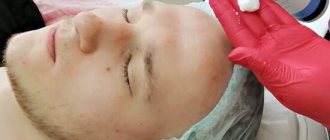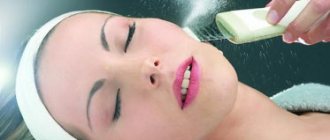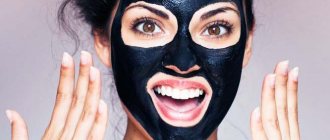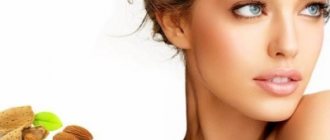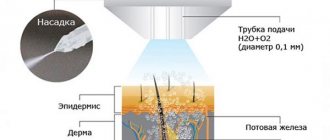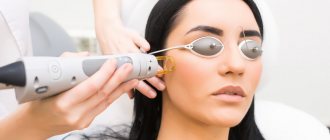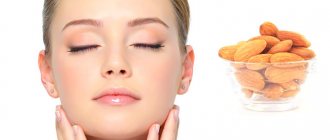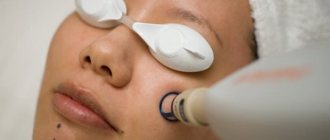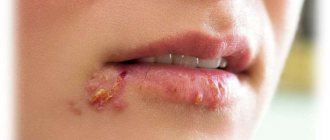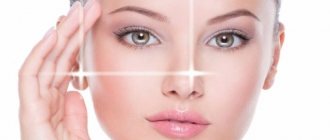Peeling and cleaning
Of course, facial cleansing and peeling are among the most popular cosmetic procedures. They allow you to make your skin cleaner and smoother, add health to it and improve its appearance.
To understand the differences between these two procedures and understand how they relate to one another, you need to look at each of them in more detail.
Face cleaning
Facial cleansing is aimed at cleaning pores: removing accumulated dirt and sebum, as well as particles of decorative cosmetics and other substances. The procedure is superficial in nature and allows you to get rid of acne, comedones, and milia.
Types of facial cleansing:
- Ultrasonic. It is performed using a special device, through a spatula-nozzle of which ultrasonic acoustic waves are applied to the skin. Ultrasound performs a vibration massage of tissues, eliminates keratinized scales, activates blood flow and opens oxygen to the skin, which helps improve metabolism and skin tone in general. However, this type of cleansing is completely ineffective in the fight against comedones.
- Vacuum. It is performed using a special device with a nozzle capable of pumping air, creating a vacuum - negative pressure. This procedure perfectly activates blood circulation and promotes rapid resorption of congestion. In addition, vacuum cleaning improves metabolic processes in tissues. But it does not help cope with severe pore contamination.
- Galvanotherapy. This skin cleansing procedure is also called disincrustation. Its essence is the directed effect of electric current on the skin. Before performing the procedure, a special solution is applied to the face, which penetrates into the pores and effectively breaks down impurities. Cosmetologists claim that galvanic cleaning can be an excellent alternative to mechanical cleaning. This procedure does not cause discomfort and does not cause damage to the skin, which is certainly a significant advantage.
- Mechanical or manual. This procedure is considered the most effective in the fight against acne, but is painful. Its essence consists of manual cleaning of pores - a specialist squeezes out comedones or removes impurities using special devices. After the skin has been cleansed, it remains red for several days and requires special care. In particular, you need to protect yourself from the sun's rays, switch to using mild care products, and avoid injuring your face with a scrub for at least one to two weeks.
Each type of facial cleansing begins with preparing the skin for the procedure, in particular, substances that can loosen the skin and comedones are applied to the face.
After completing all the manipulations, various masks and lotions with soothing and caring qualities are also used.
Peeling
Peeling is a more serious procedure, as it is aimed at deeper cleansing of the skin. Typically, such manipulation is carried out using various acids (they may differ in origin and concentration), which effectively dissolve sebum along with the top layer of dead epidermal cells.
There are several types of chemical peeling (using acids):
- Surface. It is considered the safest and easiest. The active substances in this procedure act only within the stratum corneum of the epidermis. To carry out superficial peeling, soft acids are used, for example, glycolic, lactic, malic, phytic, almond, etc. This procedure can improve complexion, reduce age spots and reduce skin oiliness. In addition, it promotes the active course of regeneration processes, smoothing wrinkles and leveling the relief.
- Median. It affects the entire length of the epidermis, right down to the papillary layer of the dermis. It is carried out using salicylic, retinoic or trichloroacetic acid. Jessner's solution can also be used. Medium peeling is a fairly uncomfortable (often painful) procedure and requires some recovery - about two weeks. Carrying out such manipulation becomes a powerful message for launching regenerative processes in the skin. Medium peeling promotes the formation of new cells, the appearance of new capillaries and the activation of collagen and elastin production.
- Deep. It is the most complex type of peeling and belongs to dermatosurgical procedures. When performed, the active substances reach the papillary layer of the dermis. Deep peeling is carried out using phenol in the form of a solution; it gives a lifting effect, but is painful and has a fairly large list of contraindications. After such a procedure, the patient needs to recover from a couple of months to six months. And it gives a noticeable rejuvenating effect, because the skin dissolves as deeply as possible. The epidermis is restored from a thin layer of cells, the so-called growth zone.
It is important to note that deep peeling is carried out exclusively with the use of anesthetics - painkillers. Only a highly qualified specialist can perform it.
Peeling can also be:
- Mechanical. It involves the use of various devices that provide exfoliation and polishing of the upper layers of the skin.
- Physical or contactless. To carry out this procedure, laser and ultrasound are used.
After any type of peeling, the skin begins to actively recover. At the same time, the barrier capabilities of the skin increase, collagen, elastin and hyaluronic acid are more actively produced. Peeling also helps normalize metabolism in tissues.
Ultrasonic facial cleansing
Cleaning is carried out using an ultrasonic spatula. An ultrasonic vibrating device removes impurities from the skin without unpleasant odors. The spatula also removes the top layer of dead cells, which renews the epidermis. Remember that ultrasound cleansing not only exfoliates the skin, but also tones, moisturizes and smoothes it.
During ultrasound cleaning, a thin layer of ozone is formed on the surface of the skin, which destroys all microbes. The skin is not only cleaned, but also thoroughly disinfected.
Ultrasound facial cleansing lasts 20-30 minutes. After it, the skin looks moisturized and healthy. The procedure has no restrictions and is absolutely safe for owners of all skin types. Ultrasound cleansing is recommended for those who cannot tolerate rough mechanical peeling, but want fresh and clean skin without unwanted marks.
Ultrasonic facial cleansing at home
Facial cleansing at home is practically no different from salon methods. The main stages of facial cleansing:
Traditional moisturizing and peeling with a roller.
Light massage to relax muscles.
Application of a special gel.
The basic cleaning process of the device.
Once you apply the gel, turn on the spatula and begin to slowly move it across the skin at a 45-degree angle. It is recommended to move along the massage lines from the sides.
After the procedure, there is no need to wash off the gel - it will evaporate on its own. If necessary, you can apply an additional layer of gel. At the end of the procedure, you need to work on the area of the wings of the nose and the central part of the face.
For the first time, use the device at low power, spending no more than 3 minutes on each area of the face.
Remove any remaining gel with a napkin.
Next, apply a thick, soothing face mask.
The final touch is a moisturizer for your skin type.
READ ALSO: Scabies: photos, symptoms
What to do after ultrasonic facial cleansing:
- In the first 72 hours, do not use decorative cosmetics.
- Apply moisturizer every hour.
- Avoid saunas, swimming and steam baths.
- Drink more fluids.
- Apply sunscreen before going outside.
- Morning and evening, refresh your skin with ice cubes. Use only filtered purified water.
https://youtu.be/https://www.youtube.com/watch?v=p4PM_I5Es_A
Indications
Cosmetologists recommend peeling and facial cleansing in various situations. So, the cleaning procedure can be done for girls with:
- Pimples.
- Comedones.
- Miliums (millet).
- Post-acne.
- Stagnant spots.
- Keratosis.
- Uneven and bumpy skin.
- Sebaceous plugs.
- Excessive oily skin.
Peeling will help cope with:
- Increased fat content.
- Pigment spots.
- Wrinkles.
- Dull skin.
- Photoaging.
- Uneven skin surface.
- Thickened stratum corneum.
- Loss of elasticity.
- Other age-related changes.
Most often, facial cleansing is recommended for girls with oily skin types, as well as those with problem skin. In addition, this procedure is often necessary for teenagers.
Girls with normal and combination skin may also need facial cleansing to get rid of various of the above problems.
As for peeling, it can be used for skin care of various types. This procedure is especially useful for those with aging skin. You can perform peeling from the age of twenty-five.
Atraumatic facial cleansing
Unlike mechanical cleansing and peeling, the atraumatic method gently cleanses the skin. No aggressive devices are used to clean pores and remove the dermis layer. This format is suitable even for sensitive skin types. Contactless cleaning (as it is also called) is carried out using deep cleansers. Professional cosmetic products painlessly dissolve comedones, sebum and blackheads. In addition, the procedure disinfects and absorbs the facial skin, which reduces and tightens pores. The cosmetic complex is selected taking into account the weather season and individual skin characteristics.
What is the difference?
Thus, after studying all the above information, it already becomes clear that peeling and cleansing are completely different procedures that differ greatly in the principle of action on the skin and indications for implementation, although in some cases they can give a similar effect. Main differences:
- Facial cleansing has no age restrictions. Peeling is carried out only after 25 years, otherwise the skin may lose its natural ability to rejuvenate itself.
- Facial cleansing is a superficial procedure. Peeling, even superficial, affects the deeper layers of the epidermis.
- Cleaning has an order of magnitude fewer contraindications than peeling.
- Peeling involves the use of more aggressive, stronger and more effective methods (means) to obtain the desired result.
It is difficult to say which is better: peeling or facial cleansing, because such procedures have slightly different purposes. They are not interchangeable, but with the right approach they can complement each other well.
Ultrasonic facial cleansing device: features of use
Ultrasonic cleaning spatulas are water-based cleaning and exfoliating devices. The flat device can only be used on damp skin. During operation, sound waves are activated, which affect dead epidermal cells and other types of contaminants.
The facial cleansing device is suitable for sensitive skin and dermis prone to redness and rosacea. Most often, these skin types react negatively to rough cleaning methods. Do not use the ultrasonic facial cleanser too often. Despite the relatively gentle method of cleansing, the procedure still injures the skin.
When choosing a facial cleanser, pay attention to its power. The optimal figure is 0.5–0.8. Also, a good device for ultrasonic facial cleansing is equipped with additional modes. For example, it may include acupuncture to inject cosmetics under the skin, ultrasound massage and iontophoresis to improve the tone and firmness of mature skin.
Combination of procedures
Many clients of cosmetology clinics are interested in how facial cleansing and peeling are combined. Of course, a qualified specialist can answer such questions.
So, quite often cosmetologists recommend doing facial cleansing a few days before peeling. This makes it possible to increase the effectiveness of the procedure by an order of magnitude. But most often, experts advise waiting about one week after cleansing until the skin’s hydrolipidic barrier is restored. It is especially important to pause between procedures if there is a need to eliminate existing traces of rashes or stagnant spots.
As for facial cleansing after peeling, the approach to combining such procedures differs depending on the list of products used, as well as the qualifications of the cosmetologist. Some specialists practice superficial peeling with acids immediately before cleansing the face. In this case, preference is given to the use of salicylic, mandelic and pyruvic acid.
Sometimes it is possible to perform a light superficial peeling, and after 3-5 days, cleansing.
In some situations, a cosmetologist may begin working on the client’s face with a superficial peel, then begin facial cleansing, and finish the procedure by re-applying the peel. If there are many comedones and inflamed areas on the skin, cleaning is often completed with a superficial alcohol-based salicylic peel. This procedure is quite aggressive and painful, but gives a good effect.
In the event that medium or deep peeling is planned, cleaning is not done either before or after it, because during the procedure the skin is quite seriously injured. In the future, cleaning can be carried out only after complete restoration of the skin (after 1–6 months).
If you carry out peeling and cleansing at the same time, it traumatizes the skin much more than performing such manipulations separately, with a certain time interval. An experienced cosmetologist can accurately answer questions about whether it is necessary and possible to do peeling after cleansing the face and cleansing after peeling.
Types of facial peels
When choosing peeling as a procedure, you should take into account its varieties, such as:
- Mechanical peeling is one of the most common. It includes subgroups that differ in depth and strength of impact. The simplest mechanical peeling is similar to a facial massage. Next comes the next level: gommage. It is based on fruit acids that gently remove dead skin layers. Facial microdermabrasion and coral peeling are considered rougher but more effective. They are also mechanical. Both types operate due to grains that are spread over the skin using a nozzle.
- Physical peeling can also be divided into levels according to the degree of penetration from light to deeper. But the main difference from mechanical peeling is the use of liquid nitrogen or dry ice. The procedure helps get rid of gray complexion and stops the processes of skin dehydration.
- Chemical peeling is the most aggressive and is used only in the most advanced cases, when pronounced skin defects require elimination. It burns the top layer due to the aggressive substance - phenol. The procedure is still controversial and few people use it without critical indicators.
Chemical peeling is performed under general anesthesia, as the pain is very high. In addition, after cosmetic surgery, the patient needs bed rest and timely skin treatment to avoid infection.
When choosing the type of peeling, you should focus on skin imperfections. The first signs of aging and rough skin indicate the need to use acid and nitrogen peels. They are more gentle and the recovery process will go quite quickly.
You will be interested in: New Year's manicure 2020: 112 photos, ideas and new nail designs
The cosmetologist decides which facial peeling is the most effective. Before the procedure, it is necessary to find out how deep the update is required by the patient. What does facial peeling do:
- Cellular renewal;
- Getting rid of toxins accumulated in the upper layer of the skin;
- Slowing down the aging process due to the death of old cells;
How much does a facial peeling cost from a cosmetologist? The answer to the question depends on the chosen salon and its pricing policy. But in general, the cost of one procedure varies from 1000 rubles. Several sessions may be required to achieve maximum results. Before making your final decision, you can watch a video of how facial peeling is done in a salon. The manual clearly shows all the intricacies of the procedure and there won’t be many questions in the cosmetologist’s office.
What's better?
You should not try to determine on your own which procedure is more necessary at the moment - facial cleansing or peeling. It is better to consult with an experienced cosmetologist and listen to his recommendations on skin care. It would also be a good idea to visit a dermatologist, especially if your skin is very problematic.
You should not ignore the recommendations of specialists, only in this case there is a chance to get a really good result and make your skin well-groomed and healthy.
